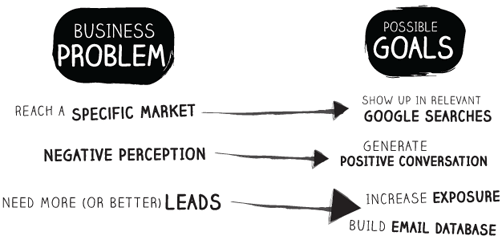This is the first of a series of three posts that will show you how to create a website that’s a REAL business tool. These posts are not for programmers or computer geeks like us. They’re for business people who believe their website shouldn’t just be a brochure about what they’re company does, but rather a tool that can target a specific audience, generate leads, gain exposure, and ultimately lead to sales.
Part 1 (this blog post) is about defining what you’re trying to accomplish with your site and setting clear goals around those things. Part 2 will be about executing a site that works toward those goals. Part 3 will be about maintaining, measuring and refining a living and breathing site that engages your audience, generates leads, brings visitors back and encourages them to share your content.
Your website is one of your most important employees
So treat it like one.
Imagine hiring a new employee, handing them a $50K salary, asking them to work hard for you for a few months and then giving them permission to go sit in the corner and hope people start calling for your business. I’m gonna go out on a limb and guess that it doesn’t work that way, right? Instead, you train your employees, you give them resources that allow them to efficiently do their specific job and you define clear expectations for them. Then you count on them to get the job done.
Well guess what? Your website needs that kind of love and attention too. Let’s take a closer look.
What do you want your site to accomplish?
This can be a tough question to answer. Maybe an easier question to ask is this: What business problems are you trying to solve? The answer to these two questions should be the same.
Let’s say you’re a service provider that’s trying to reach a specific new market. Or maybe you’re a regional business that’s getting beat up by the big guns in Google searches. Perhaps a singe mishap by a lower level employee has created an unfair and exaggerated negative perception of your business in the public eye, and you need to reverse that perception before you start losing customers. Maybe your phones aren’t ringing. Or maybe they’re ringing too much and you don’t have the personnel to handle the volume.
The bottom line is that you know better than any marketer or web developer what problems your business faces every day. So before you start making a website, those problems should be clearly identified.
Set realistic goals for your website
OK, so you’ve identified some problems that need to be solved. That’s a huge step in the planning process. Now it’s time to set some goals and expectations for what can be done to address them. Let’s stick with a few of the examples we just used.

I realize that these example goals might seem obvious, but I want to emphasize that during this goal-setting stage, it’s still too early to focus on tactics. In other words, don’t worry quite yet about HOW you’re going to accomplish the goals that you’re setting. That’s for later. Focus instead on clearly defining what the goals are. The more specific you can get, the better. But make sure they’re realistic. If you’re a boutique clothing store, you’re not going to beat Amazon.com or Macy’s in a Google search for “men’s clothing”. But if you do it right, maybe you can beat them in a search for a specific line of clothing that is unique to your store, in your specific city.
Click here to read Part 2, where I’ll focus on the process of building a site that works toward accomplishing your goals.